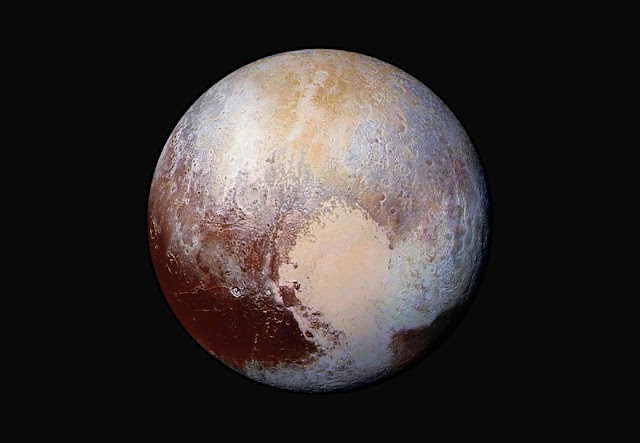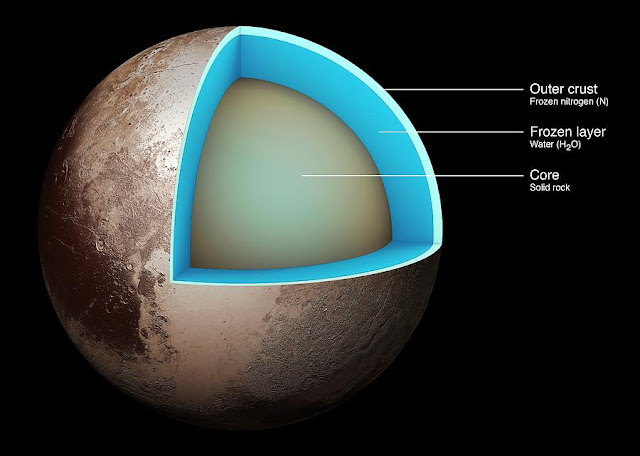The Pluto is the largest kuiper belt object. When the Pluto was discovered in 1930, the Pluto is declared as a ninth planet from our sun. But in 2006, the International Astronomical Union (IAU) defines the definition about the planate. And so, the Pluto is reclassified as a dwarf planet. So now the Neptune is the farthest planet from the sun. So, the temperature on the Pluto is -375o to -400o Fahrenheit or -226oC to -240oC. The Pluto named after the roman god of underworld. The Pluto’s rotation axis is tilted about 1200. So, as like the Uranus, the Pluto also rotates on its sides.
 |
| The Dwarf Planet Pluto |
The
Pluto is ninth largest known object which is directly orbiting the sun. Pluto’s
orbit is moderately inclined relative to the solar system’s plane over 170.
Even the Pluto is a dwarf planet, it has five moons orbiting around. The one of
moon of Pluto, charon is hydrostatic equilibrium with Pluto. This means that
the moon charon and Pluto both faces same side always.
 |
| Largest Kuiper belt object: Pluto |
The
diameter of the Pluto is only about 1400. The distance between the Pluto and
our sun is about 3.6 billion miles. The Pluto and Planet Neptune’s orbit
crosses with each orbit. But their orbits are aligned so that they can never
collide or even approach closely.
What
is Pluto?
The dwarf planet Pluto’s core is probably made
up of a rocky material. According to scientist, the core may be combination of
iron and rocky material. The core is surrounded by mantle. The mantle of Pluto
is made up of ice. The ices are of Nitrogen, Methane and Carbon Monoxide. The Nitrogen
ice is 98% of all ices and little traces of Methane and Carbon Monoxide. The
Pluto is made up of 30% of ice and 70% of rocky and iron material.
The
scientist may think according their studies about the Pluto, there must be a
decay of some material taking place inside. So, this decay increases the
temperature around it. So, this causes the ice to melt down. So, there must be
possibilities of water ocean inside the Pluto and beneath the surface of Pluto.
 |
| Inner Composition of the Pluto |
The
surface of Pluto is somewhat bigger than the Russia and half as wide as the
united states of America. The size of Pluto is very small as compared with largest
moon of Jupiter, moon Ganymede. The colour of the Pluto varies from black
charcoal, dark orange and white. The surface of Pluto is little bit same as the
moon IO. The Pluto has an area known as ‘Tombaugh Region’. This region is like
Heart shape. A large bright area on the opposite its moon charon. The western
lobe of ‘Heart’, is a nearly 1000 km or 620 miles wide basin of frozen nitrogen
and carbon monoxide ices. The
Pluto has very thin atmosphere. Atmosphere consist of nitrogen, methane and
carbon monoxide. The atmosphere Pluto is very similar to that of the comet. If
we place Pluto in inner solar system, the Pluto’s atmosphere will evaporating
and will produce a tale as like a comet has the atmosphere expands when Pluto
comes closest to the sun and collapse when it moves further away. When Pluto comes
closest to the sun the ice evaporates and converted to gaseous form. This is a
thin atmosphere generation of Pluto.
Orbit
of Pluto
The
Pluto requires 153 hours to complete one rotation about its axis of rotation.
That means one day on Pluto lasts about 153 hours, Pluto’s axis of rotation is tilted
about 1200. That means Pluto rotates on its sides as like the planet
Uranus. The orbit of Pluto is unusual. The orbit is elliptical and tilted about
170. The average orbital speed of the Pluto is nearly 4.7 km per
seconds. The aphelion of Pluto is 7.38 billion km and the perihelion of Pluto
is 4.44 billion km.
 |
| Orbit of the Pluto |
The orbit of Pluto is appearing that
it crosses the Neptune’s orbit. But both the Pluto’s and Neptune’s orbits are
aligned so that they can never collide or even approach closely. The orbits are
not intersecting. When Pluto comes closer to the sun that means it comes
closest to the orbit of the Neptune, the Pluto’s orbit passes about 8 AV. This
preventing the collision of Pluto and the Neptune.
The
scientist isn’t known whether the Pluto has a magnetic field. But the very
small size of Pluto and slow rotation suggests that the Pluto may have a little
magnetic field or may be not.
Moons
of the Pluto
The
dwarf planet Pluto has five moons orbiting around it. The five moons are
Charon, Styx, Nix, Kerberos and Hydra. According to the studies about the dwarf
planet Pluto’s moons, it suggests that the moons are formed by the collision
between the Pluto and another one Kuiper belt object. Here I explained few
moons of the dwarf planet Pluto.
 |
| Moons of the Pluto |
Charon moon of the Pluto
The Charon moon is the largest moon of
the Pluto’s five moons. And the first from the Pluto. The Charon is half the size
of the Pluto. The Pluto-Charon is the only known double planetary system in our
solar system. The Charon requires approximately 6.4 Earth days to complete one
orbit around the Pluto. The distance between Charon and the Pluto is
approximately 19,640 km or 12,200 miles. The Charon is named after the mythological
ferryman who carried souls across the river Acheron, one of the five mythical
river that surrounded Pluto’s underworld.
 |
| Largest moon of the Pluto |
The
Pluto and Charon always faces same sides to each other. The phenomenon of the
Pluto and Charon relationship is known as “Mutual tidal locking”. Due to this
Mutual tidal locking, the Charon neither rises nor sets when looking from the
Pluto. The Charon always at the same position in the Pluto’s sky. The Pluto and
the Charon are orbiting their barycenter.
Nix moon of the Pluto
The
Nix is the third moon from the Pluto, after Charon and Styx. The Nix moon is formed
from debris ejected from a massive collision between the Pluto and another
Kuiper belt object. The Nix is not perfectly sphere. The diameter of Nix is
approximately 50 km or 31 miles across its longest dimension. The name of the
Nix moon is named after the Nyx, the Greek goddess of the Night and darkness.
 |
| The Nix moon of the Pluto |
The Nix orbits the Pluto at a distance
of 48,700 km or 30,260 miles. The Nix is orbiting Pluto and it is in between
Styx and Kerbero moons. Nix orbits around Pluto is very circular and orbital
inclination is very low. The Nix moon requires approximately 25 Earth days to
complete one rotation around the Pluto. And Nix moon requires one full day and ¾
of the day to rotate around its rotational axis.
The Nix has reflective surface, this
suggests that the Nix surface may have a water ice. But Nix also appears to
vary in brightness and reflectivity. Now talk about rotation, Nix is not tidally
locked with the Pluto and tumbles chaotically. The rotational axial tilt and rotational
period vary greatly over short timescale. The varying gravitational influences
of the Pluto and Charon causes the chaotic tumbling of the Nix. Because of this
Chaotic tumbling, the Nix can occasionally flip its entire rotational axis.
Comments
Post a Comment